Hyundai Azera 2010 Workshop Manual
Manufacturer: HYUNDAI, Model Year: 2010, Model line: Azera, Model: Hyundai Azera 2010Pages: 334, PDF Size: 12.24 MB
Page 51 of 334
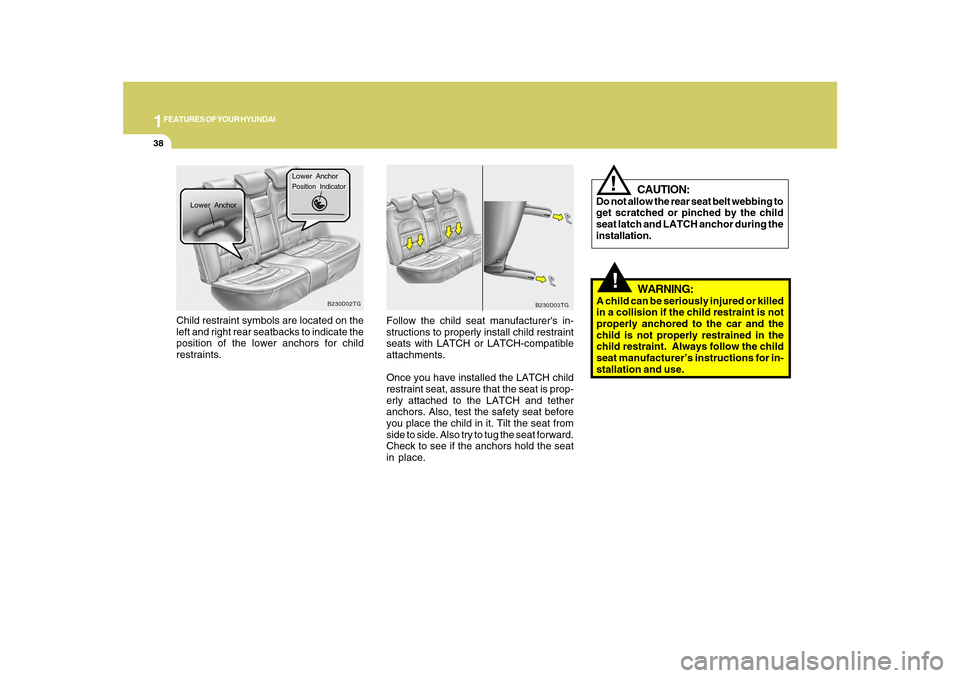
1FEATURES OF YOUR HYUNDAI38
!
WARNING:
A child can be seriously injured or killed
in a collision if the child restraint is not
properly anchored to the car and the
child is not properly restrained in the
child restraint. Always follow the child
seat manufacturer’s instructions for in-
stallation and use.
Child restraint symbols are located on the
left and right rear seatbacks to indicate the
position of the lower anchors for child
restraints.
B230D02TG
Lower AnchorLower Anchor
Position Indicator
B230D03TG
Follow the child seat manufacturer's in-
structions to properly install child restraint
seats with LATCH or LATCH-compatible
attachments.
Once you have installed the LATCH child
restraint seat, assure that the seat is prop-
erly attached to the LATCH and tether
anchors. Also, test the safety seat before
you place the child in it. Tilt the seat from
side to side. Also try to tug the seat forward.
Check to see if the anchors hold the seat
in place.
!
CAUTION:
Do not allow the rear seat belt webbing to
get scratched or pinched by the child
seat latch and LATCH anchor during the
installation.
Page 52 of 334
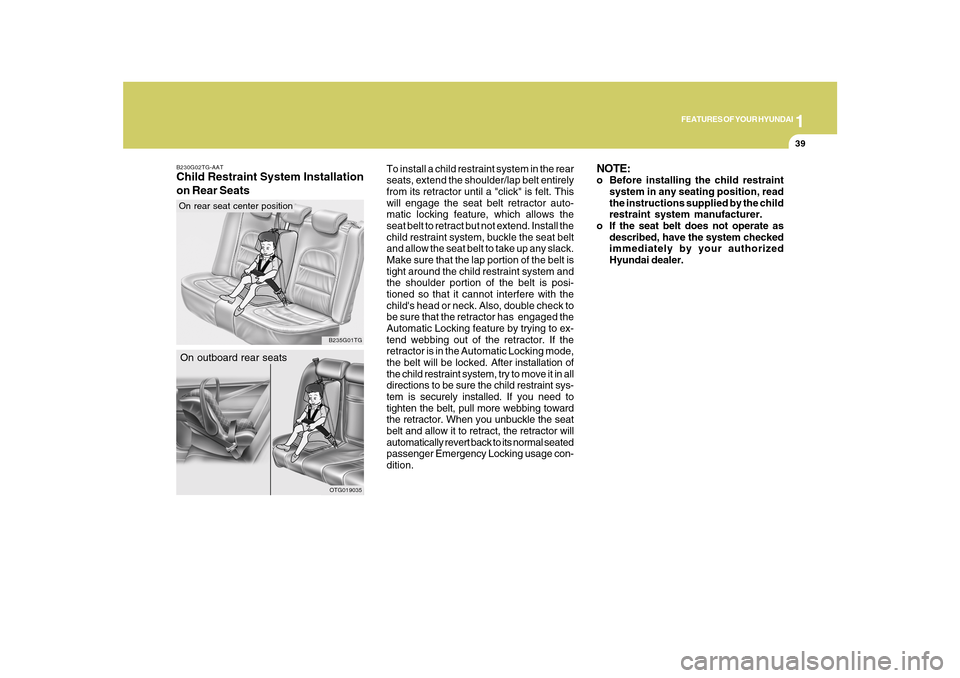
1
FEATURES OF YOUR HYUNDAI
39
To install a child restraint system in the rear
seats, extend the shoulder/lap belt entirely
from its retractor until a "click" is felt. This
will engage the seat belt retractor auto-
matic locking feature, which allows the
seat belt to retract but not extend. Install the
child restraint system, buckle the seat belt
and allow the seat belt to take up any slack.
Make sure that the lap portion of the belt is
tight around the child restraint system and
the shoulder portion of the belt is posi-
tioned so that it cannot interfere with the
child's head or neck. Also, double check to
be sure that the retractor has engaged the
Automatic Locking feature by trying to ex-
tend webbing out of the retractor. If the
retractor is in the Automatic Locking mode,
the belt will be locked. After installation of
the child restraint system, try to move it in all
directions to be sure the child restraint sys-
tem is securely installed. If you need to
tighten the belt, pull more webbing toward
the retractor. When you unbuckle the seat
belt and allow it to retract, the retractor will
automatically revert back to its normal seated
passenger Emergency Locking usage con-
dition.
B230G02TG-AATChild Restraint System Installation
on Rear Seats
OTG019035
On outboard rear seats
B235G01TG
On rear seat center position
NOTE:o Before installing the child restraint
system in any seating position, read
the instructions supplied by the child
restraint system manufacturer.
o If the seat belt does not operate as
described, have the system checked
immediately by your authorized
Hyundai dealer.
Page 53 of 334
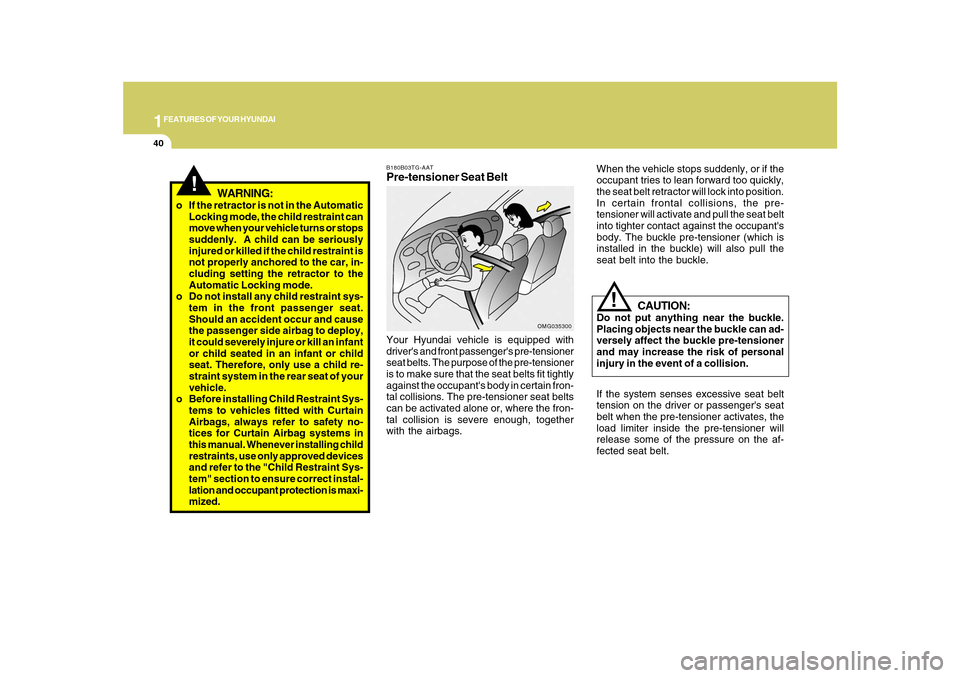
1FEATURES OF YOUR HYUNDAI40
!
CAUTION:
Do not put anything near the buckle.
Placing objects near the buckle can ad-
versely affect the buckle pre-tensioner
and may increase the risk of personal
injury in the event of a collision.
If the system senses excessive seat belt
tension on the driver or passenger's seat
belt when the pre-tensioner activates, the
load limiter inside the pre-tensioner will
release some of the pressure on the af-
fected seat belt. When the vehicle stops suddenly, or if the
occupant tries to lean forward too quickly,
the seat belt retractor will lock into position.
In certain frontal collisions, the pre-
tensioner will activate and pull the seat belt
into tighter contact against the occupant's
body. The buckle pre-tensioner (which is
installed in the buckle) will also pull the
seat belt into the buckle.
!
WARNING:
o If the retractor is not in the Automatic
Locking mode, the child restraint can
move when your vehicle turns or stops
suddenly. A child can be seriously
injured or killed if the child restraint is
not properly anchored to the car, in-
cluding setting the retractor to the
Automatic Locking mode.
o Do not install any child restraint sys-
tem in the front passenger seat.
Should an accident occur and cause
the passenger side airbag to deploy,
it could severely injure or kill an infant
or child seated in an infant or child
seat. Therefore, only use a child re-
straint system in the rear seat of your
vehicle.
o Before installing Child Restraint Sys-
tems to vehicles fitted with Curtain
Airbags, always refer to safety no-
tices for Curtain Airbag systems in
this manual. Whenever installing child
restraints, use only approved devices
and refer to the "Child Restraint Sys-
tem" section to ensure correct instal-
lation and occupant protection is maxi-
mized.
B180B03TG-AATPre-tensioner Seat BeltYour Hyundai vehicle is equipped with
driver's and front passenger's pre-tensioner
seat belts. The purpose of the pre-tensioner
is to make sure that the seat belts fit tightly
against the occupant's body in certain fron-
tal collisions. The pre-tensioner seat belts
can be activated alone or, where the fron-
tal collision is severe enough, together
with the airbags.
OMG035300
Page 54 of 334
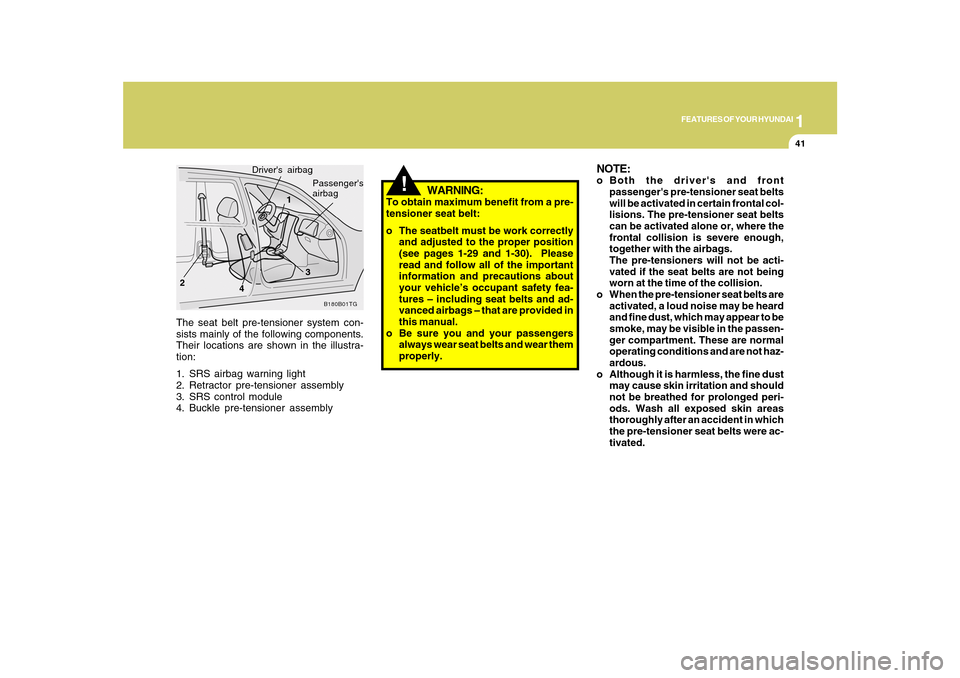
1
FEATURES OF YOUR HYUNDAI
41
!
The seat belt pre-tensioner system con-
sists mainly of the following components.
Their locations are shown in the illustra-
tion:
1. SRS airbag warning light
2. Retractor pre-tensioner assembly
3. SRS control module
4. Buckle pre-tensioner assembly
B180B01TG
1
23 Driver's airbag
Passenger's
airbag
WARNING:
To obtain maximum benefit from a pre-
tensioner seat belt:
o The seatbelt must be work correctly
and adjusted to the proper position
(see pages 1-29 and 1-30). Please
read and follow all of the important
information and precautions about
your vehicle’s occupant safety fea-
tures – including seat belts and ad-
vanced airbags – that are provided in
this manual.
o Be sure you and your passengers
always wear seat belts and wear them
properly.
4
NOTE:o Both the driver's and front
passenger's pre-tensioner seat belts
will be activated in certain frontal col-
lisions. The pre-tensioner seat belts
can be activated alone or, where the
frontal collision is severe enough,
together with the airbags.
The pre-tensioners will not be acti-
vated if the seat belts are not being
worn at the time of the collision.
o When the pre-tensioner seat belts are
activated, a loud noise may be heard
and fine dust, which may appear to be
smoke, may be visible in the passen-
ger compartment. These are normal
operating conditions and are not haz-
ardous.
o Although it is harmless, the fine dust
may cause skin irritation and should
not be breathed for prolonged peri-
ods. Wash all exposed skin areas
thoroughly after an accident in which
the pre-tensioner seat belts were ac-
tivated.
Page 55 of 334
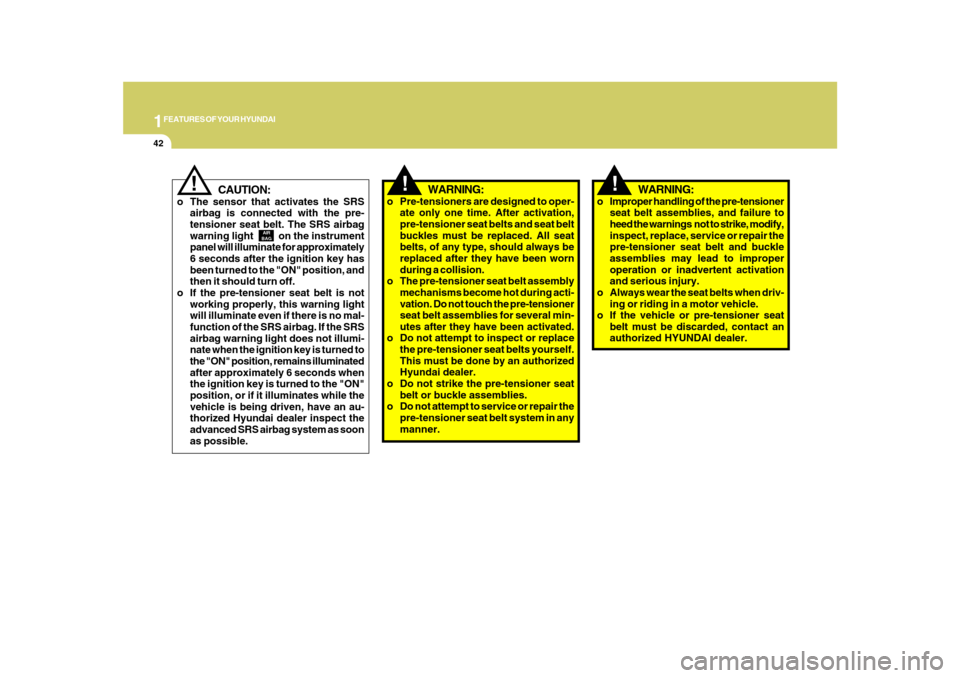
1FEATURES OF YOUR HYUNDAI42
!
WARNING:
o Improper handling of the pre-tensioner
seat belt assemblies, and failure to
heed the warnings not to strike, modify,
inspect, replace, service or repair the
pre-tensioner seat belt and buckle
assemblies may lead to improper
operation or inadvertent activation
and serious injury.
o Always wear the seat belts when driv-
ing or riding in a motor vehicle.
o If the vehicle or pre-tensioner seat
belt must be discarded, contact an
authorized HYUNDAI dealer.
!
AIR
BAG
CAUTION:
o The sensor that activates the SRS
airbag is connected with the pre-
tensioner seat belt. The SRS airbag
warning light on the instrument
panel will illuminate for approximately
6 seconds after the ignition key has
been turned to the "ON" position, and
then it should turn off.
o If the pre-tensioner seat belt is not
working properly, this warning light
will illuminate even if there is no mal-
function of the SRS airbag. If the SRS
airbag warning light does not illumi-
nate when the ignition key is turned to
the "ON" position, remains illuminated
after approximately 6 seconds when
the ignition key is turned to the "ON"
position, or if it illuminates while the
vehicle is being driven, have an au-
thorized Hyundai dealer inspect the
advanced SRS airbag system as soon
as possible.
!
WARNING:
o Pre-tensioners are designed to oper-
ate only one time. After activation,
pre-tensioner seat belts and seat belt
buckles must be replaced. All seat
belts, of any type, should always be
replaced after they have been worn
during a collision.
o The pre-tensioner seat belt assembly
mechanisms become hot during acti-
vation. Do not touch the pre-tensioner
seat belt assemblies for several min-
utes after they have been activated.
o Do not attempt to inspect or replace
the pre-tensioner seat belts yourself.
This must be done by an authorized
Hyundai dealer.
o Do not strike the pre-tensioner seat
belt or buckle assemblies.
o Do not attempt to service or repair the
pre-tensioner seat belt system in any
manner.
Page 56 of 334
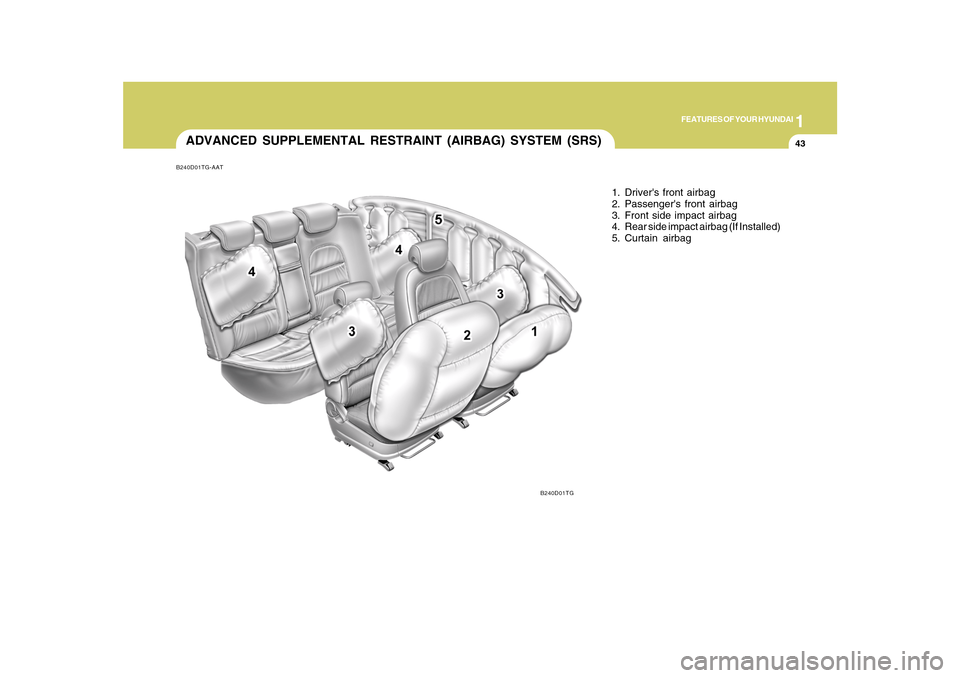
1
FEATURES OF YOUR HYUNDAI
43
B240D01TG-AATADVANCED SUPPLEMENTAL RESTRAINT (AIRBAG) SYSTEM (SRS)
1. Driver's front airbag
2. Passenger's front airbag
3. Front side impact airbag
4. Rear side impact airbag (If Installed)
5. Curtain airbag
B240D01TG
Page 57 of 334
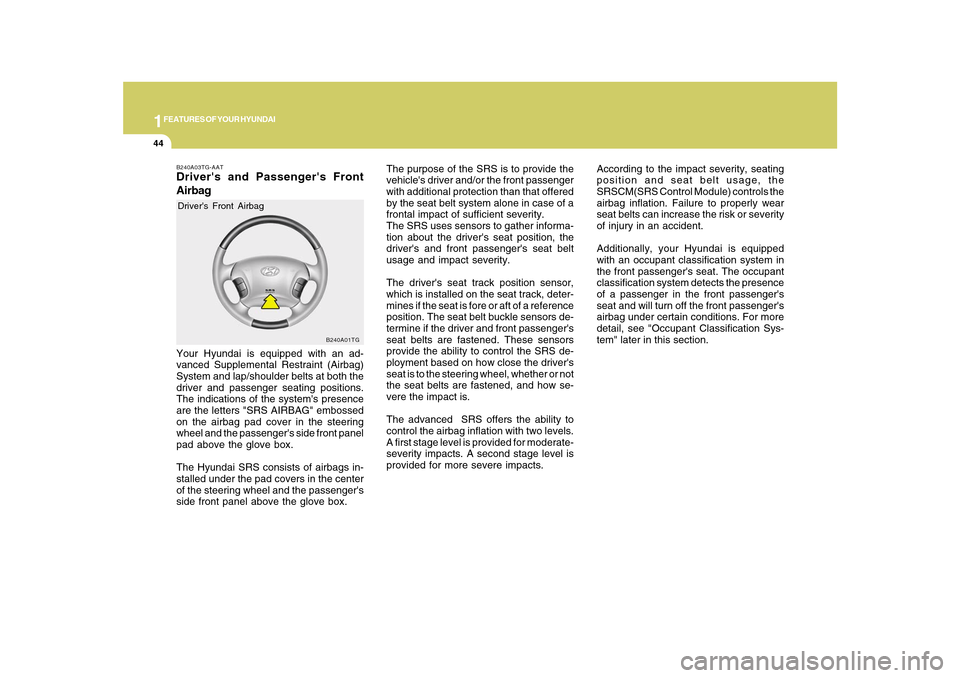
1FEATURES OF YOUR HYUNDAI44
B240A01TG
The purpose of the SRS is to provide the
vehicle's driver and/or the front passenger
with additional protection than that offered
by the seat belt system alone in case of a
frontal impact of sufficient severity.
The SRS uses sensors to gather informa-
tion about the driver's seat position, the
driver's and front passenger's seat belt
usage and impact severity.
The driver's seat track position sensor,
which is installed on the seat track, deter-
mines if the seat is fore or aft of a reference
position. The seat belt buckle sensors de-
termine if the driver and front passenger's
seat belts are fastened. These sensors
provide the ability to control the SRS de-
ployment based on how close the driver's
seat is to the steering wheel, whether or not
the seat belts are fastened, and how se-
vere the impact is.
The advanced SRS offers the ability to
control the airbag inflation with two levels.
A first stage level is provided for moderate-
severity impacts. A second stage level is
provided for more severe impacts.According to the impact severity, seating
position and seat belt usage, the
SRSCM(SRS Control Module) controls the
airbag inflation. Failure to properly wear
seat belts can increase the risk or severity
of injury in an accident.
Additionally, your Hyundai is equipped
with an occupant classification system in
the front passenger's seat. The occupant
classification system detects the presence
of a passenger in the front passenger's
seat and will turn off the front passenger's
airbag under certain conditions. For more
detail, see "Occupant Classification Sys-
tem" later in this section.
B240A03TG-AATDriver's and Passenger's Front
AirbagYour Hyundai is equipped with an ad-
vanced Supplemental Restraint (Airbag)
System and lap/shoulder belts at both the
driver and passenger seating positions.
The indications of the system's presence
are the letters "SRS AIRBAG" embossed
on the airbag pad cover in the steering
wheel and the passenger's side front panel
pad above the glove box.
The Hyundai SRS consists of airbags in-
stalled under the pad covers in the center
of the steering wheel and the passenger's
side front panel above the glove box.Driver's Front Airbag
Page 58 of 334
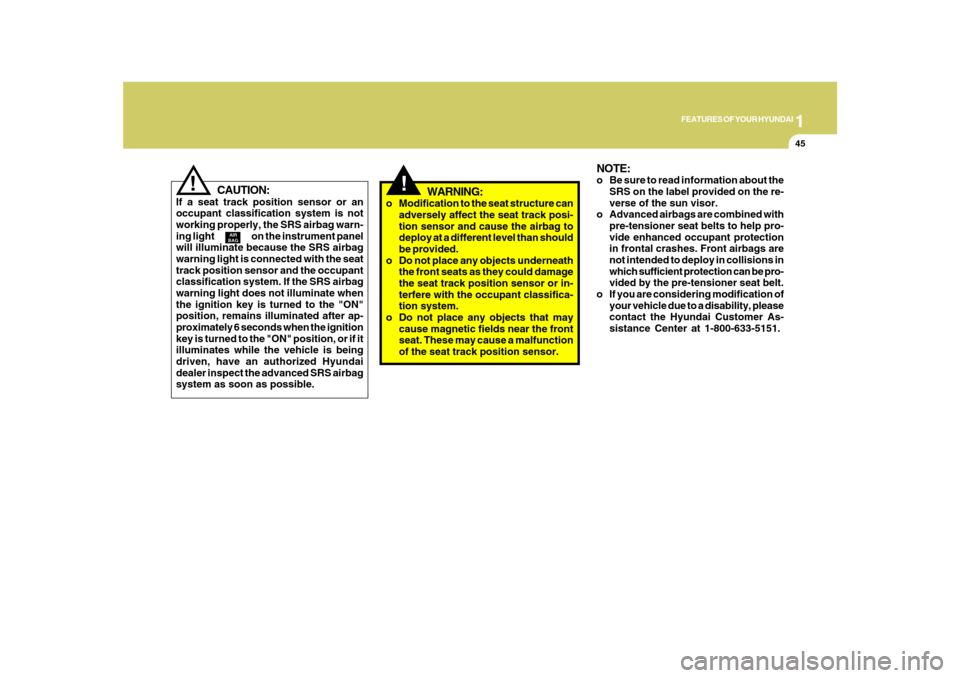
1
FEATURES OF YOUR HYUNDAI
45
CAUTION:
If a seat track position sensor or an
occupant classification system is not
working properly, the SRS airbag warn-
ing light on the instrument panel
will illuminate because the SRS airbag
warning light is connected with the seat
track position sensor and the occupant
classification system. If the SRS airbag
warning light does not illuminate when
the ignition key is turned to the "ON"
position, remains illuminated after ap-
proximately 6 seconds when the ignition
key is turned to the "ON" position, or if it
illuminates while the vehicle is being
driven, have an authorized Hyundai
dealer inspect the advanced SRS airbag
system as soon as possible.
!
AIR
BAG
!
WARNING:
o Modification to the seat structure can
adversely affect the seat track posi-
tion sensor and cause the airbag to
deploy at a different level than should
be provided.
o Do not place any objects underneath
the front seats as they could damage
the seat track position sensor or in-
terfere with the occupant classifica-
tion system.
o Do not place any objects that may
cause magnetic fields near the front
seat. These may cause a malfunction
of the seat track position sensor.
NOTE:o Be sure to read information about the
SRS on the label provided on the re-
verse of the sun visor.
o Advanced airbags are combined with
pre-tensioner seat belts to help pro-
vide enhanced occupant protection
in frontal crashes. Front airbags are
not intended to deploy in collisions in
which sufficient protection can be pro-
vided by the pre-tensioner seat belt.
o If you are considering modification of
your vehicle due to a disability, please
contact the Hyundai Customer As-
sistance Center at 1-800-633-5151.
Page 59 of 334
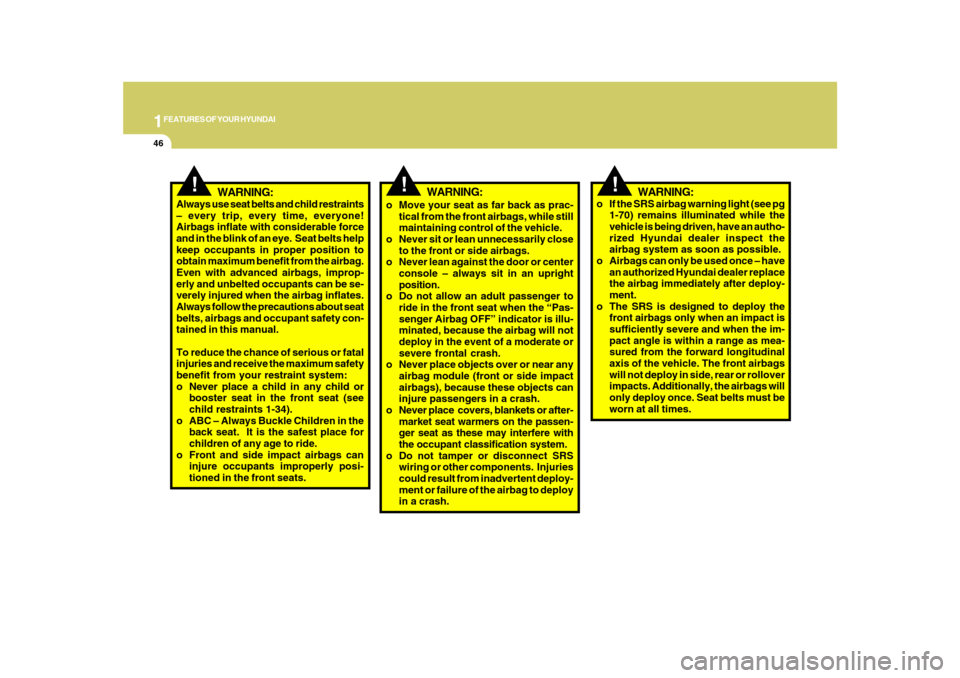
1FEATURES OF YOUR HYUNDAI46
!
WARNING:
!
WARNING:
o Move your seat as far back as prac-
tical from the front airbags, while still
maintaining control of the vehicle.
o Never sit or lean unnecessarily close
to the front or side airbags.
o Never lean against the door or center
console – always sit in an upright
position.
o Do not allow an adult passenger to
ride in the front seat when the “Pas-
senger Airbag OFF” indicator is illu-
minated, because the airbag will not
deploy in the event of a moderate or
severe frontal crash.
o Never place objects over or near any
airbag module (front or side impact
airbags), because these objects can
injure passengers in a crash.
o Never place covers, blankets or after-
market seat warmers on the passen-
ger seat as these may interfere with
the occupant classification system.
o Do not tamper or disconnect SRS
wiring or other components. Injuries
could result from inadvertent deploy-
ment or failure of the airbag to deploy
in a crash.
!
WARNING:
Always use seat belts and child restraints
– every trip, every time, everyone!
Airbags inflate with considerable force
and in the blink of an eye. Seat belts help
keep occupants in proper position to
obtain maximum benefit from the airbag.
Even with advanced airbags, improp-
erly and unbelted occupants can be se-
verely injured when the airbag inflates.
Always follow the precautions about seat
belts, airbags and occupant safety con-
tained in this manual.
To reduce the chance of serious or fatal
injuries and receive the maximum safety
benefit from your restraint system:
o Never place a child in any child or
booster seat in the front seat (see
child restraints 1-34).
o ABC – Always Buckle Children in the
back seat. It is the safest place for
children of any age to ride.
o Front and side impact airbags can
injure occupants improperly posi-
tioned in the front seats.o If the SRS airbag warning light (see pg
1-70) remains illuminated while the
vehicle is being driven, have an autho-
rized Hyundai dealer inspect the
airbag system as soon as possible.
o Airbags can only be used once – have
an authorized Hyundai dealer replace
the airbag immediately after deploy-
ment.
o The SRS is designed to deploy the
front airbags only when an impact is
sufficiently severe and when the im-
pact angle is within a range as mea-
sured from the forward longitudinal
axis of the vehicle. The front airbags
will not deploy in side, rear or rollover
impacts. Additionally, the airbags will
only deploy once. Seat belts must be
worn at all times.
Page 60 of 334
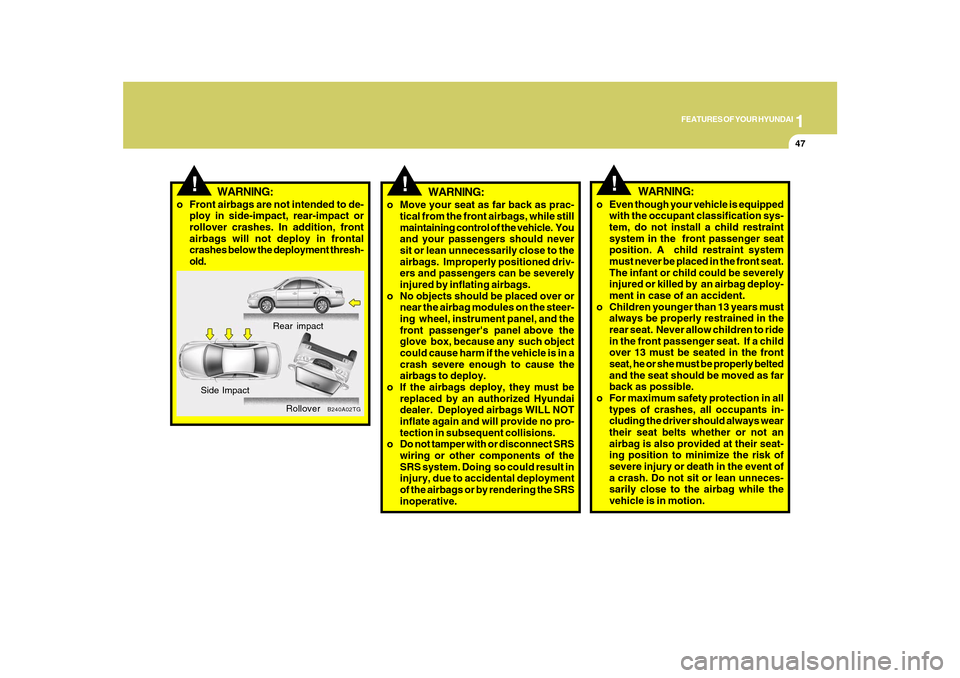
1
FEATURES OF YOUR HYUNDAI
47
!
WARNING:
o Move your seat as far back as prac-
tical from the front airbags, while still
maintaining control of the vehicle. You
and your passengers should never
sit or lean unnecessarily close to the
airbags. Improperly positioned driv-
ers and passengers can be severely
injured by inflating airbags.
o No objects should be placed over or
near the airbag modules on the steer-
ing wheel, instrument panel, and the
front passenger's panel above the
glove box, because any such object
could cause harm if the vehicle is in a
crash severe enough to cause the
airbags to deploy.
o If the airbags deploy, they must be
replaced by an authorized Hyundai
dealer. Deployed airbags WILL NOT
inflate again and will provide no pro-
tection in subsequent collisions.
o Do not tamper with or disconnect SRS
wiring or other components of the
SRS system. Doing so could result in
injury, due to accidental deployment
of the airbags or by rendering the SRS
inoperative.
o Even though your vehicle is equipped
with the occupant classification sys-
tem, do not install a child restraint
system in the front passenger seat
position. A child restraint system
must never be placed in the front seat.
The infant or child could be severely
injured or killed by an airbag deploy-
ment in case of an accident.
o Children younger than 13 years must
always be properly restrained in the
rear seat. Never allow children to ride
in the front passenger seat. If a child
over 13 must be seated in the front
seat, he or she must be properly belted
and the seat should be moved as far
back as possible.
o For maximum safety protection in all
types of crashes, all occupants in-
cluding the driver should always wear
their seat belts whether or not an
airbag is also provided at their seat-
ing position to minimize the risk of
severe injury or death in the event of
a crash. Do not sit or lean unneces-
sarily close to the airbag while the
vehicle is in motion.
!
WARNING:
!
WARNING:
B240A02TG
Rear impact
Side Impact
Rollover
o Front airbags are not intended to de-
ploy in side-impact, rear-impact or
rollover crashes. In addition, front
airbags will not deploy in frontal
crashes below the deployment thresh-
old.